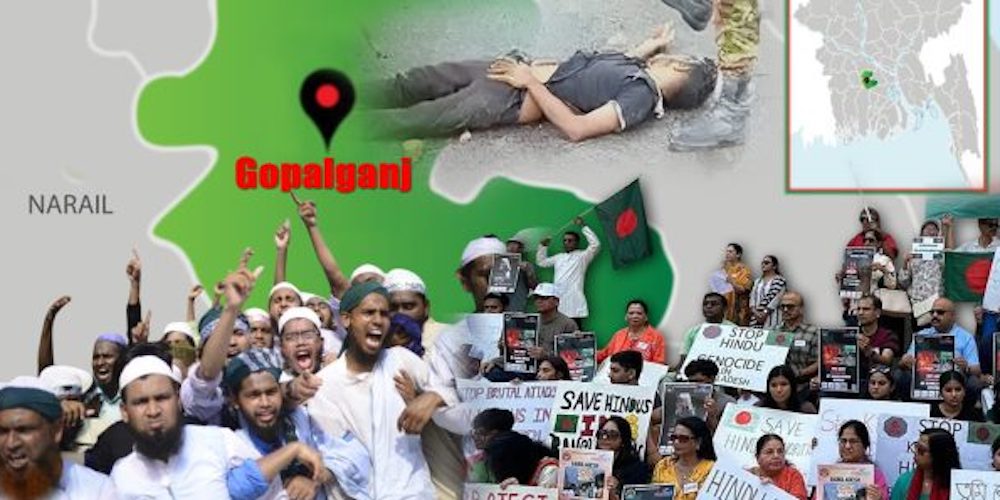Why Islamists are targeting Gopalganj: The silent ethnic cleansing in Bangladesh

Since July 16, more than 1.3 million residents of Gopalganj – a district in the southern part of Bangladesh – have been living under extreme fear and uncertainty. What began as a political provocation has evolved into a campaign of terror, as members of law enforcement agencies, security forces, and even the Bangladesh Army have launched sweeping raids across the district. Dozens of homes have been stormed, and numerous civilians – men, women, and even children – have reportedly been detained or abducted under the baseless accusation of being affiliated with the Awami League, the country’s oldest and largest political party, which has now been banned by the ruling Islamist-jihadist regime led by Muhammad Yunus
These nightmarish actions have plunged the entire district into chaos. Since the evening of July 16 – now marked as a Black Day in Bangladesh’s modern history – an indefinite curfew has been imposed. The district has effectively been turned into a militarized zone. Behind the scenes, there appears to be a sinister motive: to facilitate the rise of the National Citizen Party (NCP), an unregistered and unpopular political platform widely known as the “King’s Party” for enjoying the direct patronage of Muhammad Yunus and his radical Islamist allies.
What is perhaps most disturbing is the global silence surrounding this tragedy. International rights organizations such as Amnesty International, Human Rights Watch, and even leading Western media outlets have maintained an inexplicable silence. The United Nations, which frequently speaks out on human rights issues in various countries, has remained completely mute about the July 16 Gopalganj Massacre.
This silence is even more troubling considering that the Yunus regime recently signed a Memorandum of Understanding (MoU) with the Office of the United Nations High Commissioner for Human Rights (OHCHR), permitting the UN to open a mission in Bangladesh. While this may appear to be a step toward improving human rights, many fear it is part of a broader, more insidious agenda. The UN has long sought access to Myanmar’s Arakan State through a so-called “humanitarian corridor” via Bangladesh. The opening of the OHCHR office could very well be the first step toward establishing a Western-backed military corridor. In this context, the UN’s silence on the massacre appears to be a calculated decision, aimed at securing strategic advantages in the region – even at the cost of justice and truth.
To understand the events of July 16, one must grasp the cultural and historical significance of Gopalganj. That day, leaders and activists of the NCP entered the district with the provocative and deeply offensive intention of demolishing the ancestral home and grave of Bangabandhu Sheikh Mujibur Rahman, the founding father of Bangladesh. This plan had been widely circulated on social media by NCP leaders and their jihadist patrons, inciting fury among the local population.
Adding to the tension, Islamist-jihadist networks had earlier declared their intention to rename Gopalganj with an “Islamic” name, erasing its cultural roots. But why this hatred toward Gopalganj?
Historically, Gopalganj has been a stronghold of Hindu and Bengali heritage. In 1800, Babu Preetoram Marh, the zamindar of Janbazar in Kolkata, purchased Makimpur Pargana (now part of Gopalganj) for 19,000 takas. His son, Babu Rajachandra Das, married Rani Rasmoni in 1804. After Rajachandra’s death, Rani Rasmoni managed the estate and played a pivotal role in the social and cultural landscape of Bengal. The name “Gopalganj” itself originates from Nabo Gopal, Rani Rasmoni’s grandson.

Even earlier, during the ancient and medieval periods, Kotalipara – a part of Gopalganj – was the capital of the Gangaridai Dynasty around 300 BC. The area was ruled by Hindu kings during the Sultanate and Mughal eras, symbolizing a continuity of Bengal’s pluralistic traditions.
What Bangladesh is currently experiencing is a wave of cultural destruction, ethnic cleansing, and historical revisionism. The Yunus regime has unleashed a campaign to systematically erase symbols of national unity and heritage.
Consider the demolition of the ancestral home of Satyajit Ray in Mymensingh. This was not just a structure; it was a living symbol of the Bengali cultural renaissance, bridging literature, film, and identity across the subcontinent. Despite public outrage and historical evidence, the regime dismissed any link between the site and Ray’s legacy. The message was clear: heritage that does not align with the regime’s radical ideology is disposable.
The same fate has befallen sites connected to Sheikh Mujibur Rahman and Rabindranath Tagore. It’s not just about physical structures – it’s a psychological war aimed at rewriting history, isolating Bangladesh from its pluralistic roots, and replacing it with a rigid, Islamist narrative.
Since August 2024, there has been a sharp rise in violence against religious minorities – Hindus, Buddhists, and Christians. Temples have been vandalized, minority homes set ablaze, and families displaced.
In Gopalganj, the violence on July 16 was not a spontaneous outburst; it was a carefully planned act of terror. Over five individuals were killed and buried or cremated without any autopsy – a clear violation of legal procedures. The security forces, who should have protected civilians, actively took part in the bloodshed.
The imposition of an indefinite curfew wasn’t about public safety – it was about information control. The regime sought to isolate the district, cut off communication, and prevent the truth from emerging. Today, Gopalganj has essentially become a no-go zone, shrouded in silence and fear.
Gopalganj holds symbolic importance as the birthplace of Sheikh Mujibur Rahman, but also as the largest Hindu-majority district in Bangladesh. Historically, even political parties like the BNP and Jamaat-e-Islami were able to conduct peaceful activities in the region. But now, under the guise of an NCP rally, the regime has weaponized state machinery to orchestrate a targeted massacre.
This calculated act of aggression sends a chilling message: even in regions historically marked by communal harmony, minorities are no longer safe. The broader goal seems evident – to Islamize Bangladesh by targeting and depopulating Hindu-majority regions, thereby consolidating the regime’s radical Islamic agenda.
The July 16 massacre in Gopalganj is not an isolated incident. It is part of a coordinated campaign of ethnic cleansing, cultural erasure, and religious persecution orchestrated by the Islamist-jihadist regime of Muhammad Yunus. By remaining silent, international organizations are not just complicit – they are enabling the slow annihilation of Bangladesh’s pluralistic soul. If the world continues to ignore this unfolding tragedy, it won’t be long before Bangladesh – a country born from a secular, democratic aspiration – becomes a dystopian state governed by fear, extremism, and authoritarianism.
The world must wake up – before Gopalganj becomes the template for every minority region in South Asia.
(Salah Uddin Shoaib Choudhury is an award-winning journalist, writer, and Editor of the newspaper Blitz. He specializes in counterterrorism and regional geopolitics. Follow him on X: @Salah_Shoaib)


